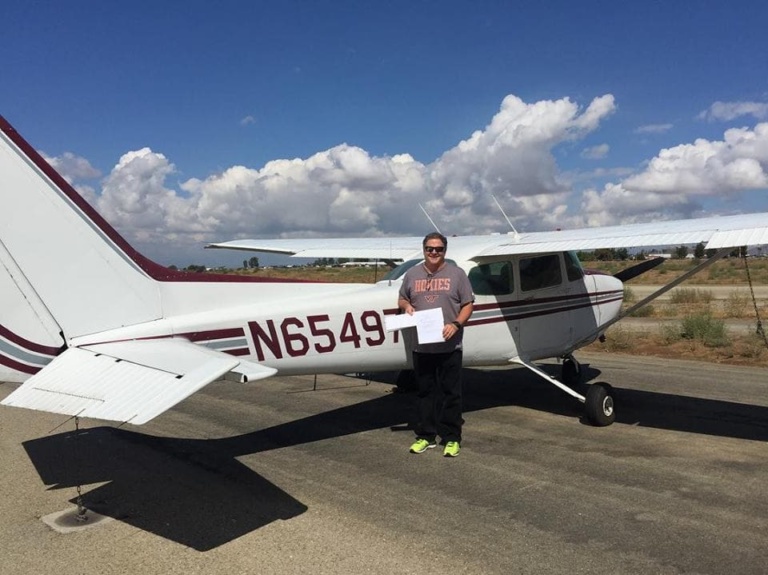Since I was a young boy I always wanted to fly, due to a series of injuries to my right eye I knew I would never qualify for military service as a pilot, for me that was the only option to get behind a yoke. Over the years I would be lucky enough to fly as a passenger on commercial carriers and once in a while to fly in a private plane or helicopter.
I became very good friends with Art Treff in North Carolina who was a private pilot and his stories and experiences were infectious. His dad was a WWII fighter pilot, Art had built his own plane and flown many other aircraft. But that did not really change my reality for becoming a pilot until a job change that brought me back to California 5 years ago. I started a construction company with my partner who was a real estate developer. He owns several buildings around the state, and he had purchased a Bonanza 35A “V” tail to fly around to his buildings 12 years ago. He is a bit older than me and he is beginning to slow down a bit work wise so he asked me to get my pilots license so I could fly around to his buildings for work. It took me a nanosecond to say yes.
His plane is base at John Wayne and I live here in Riverside, so we decided that I should train here in Riverside. I interviewed several schools and felt good about Riverside Fight Academy, so I started my instruction in June of 2016.
I had 3 instructors that prepared me for my private pilots’ exam that I passed in November 2016. Having multiple instructors, I have learned, is quite typical for two reasons: 1- the industry is expanding and changing quite rapidly since the military has cut back on their pilot pool and the existing public pool of pilots are aging out, creating a demand. So, instructors (CFI’s) are advancing in their profession and getting first officer jet jobs at an increased rate. 2- as a student and CFI work together they sometimes find that there is a learning “block”, it may be the student or the CFI but being adaptable is in the best interest of the student to advance.
To fly the Bonanza, I need to get my instrument rating. That was hard, really hard. It was the hardest thing I have ever done in my life. I am a licensed general contractor, and architect. Becoming an architect is 5 years of school, 8 years of work / school experience and passing 9 exams, one that is an oral. 50% of the candidates that take the architecture oral exam fail. All of that was nothing compared to instrument certification, training and passing the exams (written and practical).
In October 2018 I became a certified instrument rated private pilot single engine land. If I never fly an instrument flight plan again in my life it was all worth it, it made me a much better pilot. I had 3 instructors during my instrument training. Each of the changes I made with my instructors were positive and necessary. The first one I just did not get along with, I did not trust him. My second was outstanding but I was struggling with keeping the plane on course and level, while dealing with the instruments and communications. Together we decided that I should try someone else. My finisher CFI really helped me get my flying skills tuned in.
I also developed a great relationship with another student pilot now CFI at Riverside Flight Academy, Gabe Callazo. We flew a lot together as each other’s safety pilot to practice our IFR procedures and flying. Gabe was key to my success.
Learning to fly is a process, it is skill based. You need the academic knowledge and boy there is plenty of that you need to know but never forget: it gets down to skills that you need to master. You cannot force it; you need to learn the muscle memory. Some people learn it fast, others much slower, never compare your progress with others. You need to be humble; flying is serious business; it will kill you in a “New York second” if you forget to respect it, or you get cavalier or arrogant. Also, if a pilot makes a mistake 9 times out of 10, he/she will kill someone else who was trusting the pilot. Also, you need to be confident despite your fear. If fear is always wining, you should probably stop flying. Confidence is good and necessary. Again, it is all a balance. But most important it is a total blast to fly, fun as heck and it is pretty cool when you get to tell people that you are a pilot. I get way more respect as a pilot than I do as an architect!

I am now training in the Bonanza to get my high-performance complex certification. I will continue to train and enjoy flying, I hope you do to!
Tory Stephen

